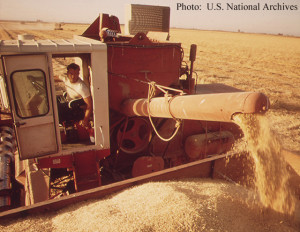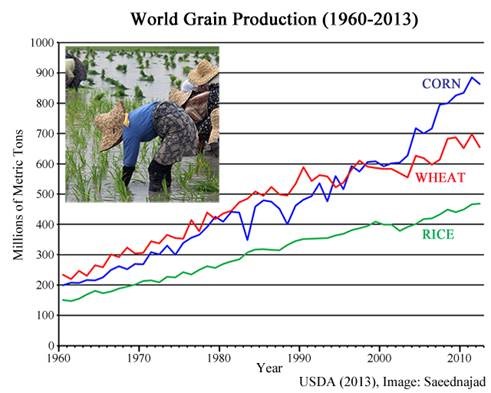
The year 2013 has been a great year for global agriculture. Record world production of rice and healthy production of wheat and corn produced strong harvests across the world. These gains were achieved despite continuing predictions that world agricultural output is headed for a decline.
The US Department of Agriculture (USDA) reports that world rice harvests for 2012/2013 were a record 469 million metric tons. Corn and wheat harvests were also strong, following record harvests for both grains during the 2011/2012 season. The USDA is now projecting world record harvests for corn, wheat, and rice for 2013/2014.
See this graph:
These numbers cap a 50-year trend of remarkable growth in world grain production. Since 1960, global wheat and rice production has tripled, and corn production is almost five times higher.
For decades, doomsayers predicted that food production would fail to keep up with the needs of humanity. In 1972, Donella Meadows and others of the Massachusetts Institute of Technology published The Limits to Growth, which asked the question, “Do these rather dismal statistics mean that the limits of food production on the earth have already been reached?” Paul Ehrlich wrote in The End of Affluence in 1974, “Due to a combination of ignorance, greed and callousness, a situation has been created that could lead to a billion or more people starving to death.”
But Norman Borlaug’s development of disease-resistant, high-yield strains of wheat and rice had already revolutionized twentieth century agriculture. A few years before Meadows and Ehrlich warned about coming famines, Borlaug’s wheat and rice were introduced into Latin America and Asia with astounding results. Mexico’s wheat production soared six-fold by 1970 from levels in the 1940s. India’s wheat production jumped from a huge deficit in 1965 to a surplus only five years later.
Food production continues to grow faster than population. Data from the Food and Agriculture Organization (FAO) of the United Nations shows a 30 percent gain in the per capita agricultural production index from 1980 to 2010. World citizens have access to more grain, meat, dairy products, and fruits and vegetables. Even fish production is climbing with large gains in aquaculture fish farming.
The increased availability of food reduced the undernourished portion of the world’s population from 18.6 percent in 1990 to 12.5 percent in 2010, according to the FAO. A total of 868 million people are still classified as undernourished.
Today’s leading agriculture alarmists are proponents of the ideology of Climatism, the belief that man-made greenhouse gases are destroying Earth’s climate. Earlier this month, a leaked draft report from Working Group II of the Intergovernmental Panel on Climate Change predicted that man-made climate change would reduce global agricultural production yields by up to two percent per decade throughout the twenty-first century.
Lester Brown’s Earth Policy Institute has long been a predictor of agricultural collapse. His website states, “…climate change is heightening the likelihood of weather extremes, like heat waves, droughts, and flooding, that can so easily decimate harvests.” Even the USDA warns that man-made climate change threatens US agriculture.
Yet, one must wonder when the climate-damaging effects on agriculture will appear. The IPCC states that 1983-2012 was likely the warmest 30-year period in the Northern Hemisphere of the last 1,400 years. Certainly we should have seen some negative agricultural impact by now?
Maybe rising agricultural production is like rising polar bear populations―the decline begins tomorrow.
Originally published in The Washington Times
Steve Goreham is executive director of the Climate Science Coalition of America and author of the book The Mad, Mad, Mad World of Climatism: Mankind and Climate Change Mania.

